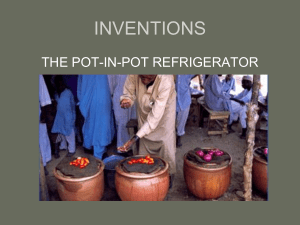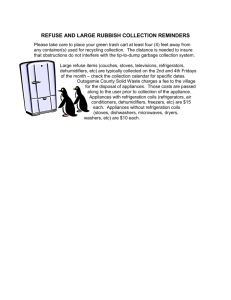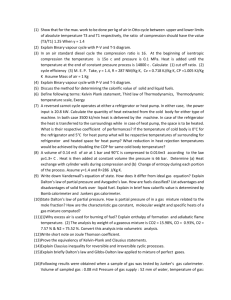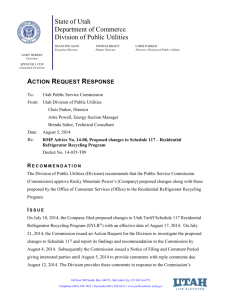How a Refrigerator Works By Elizabeth G. 2012
advertisement
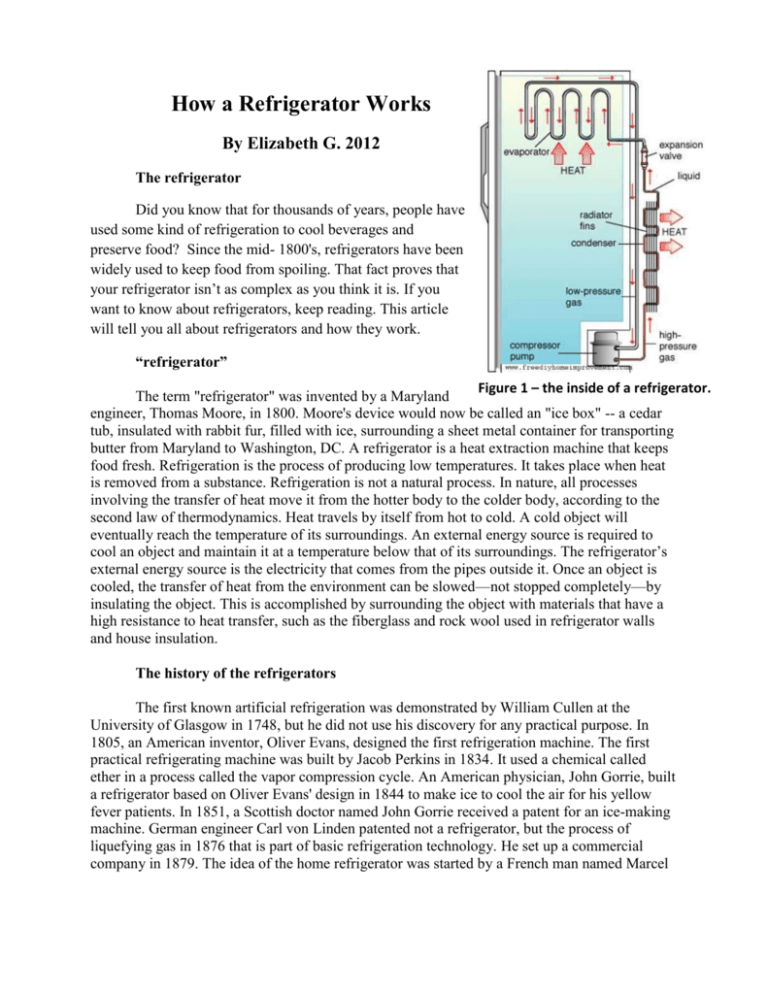
How a Refrigerator Works By Elizabeth G. 2012 The refrigerator Did you know that for thousands of years, people have used some kind of refrigeration to cool beverages and preserve food? Since the mid- 1800's, refrigerators have been widely used to keep food from spoiling. That fact proves that your refrigerator isn’t as complex as you think it is. If you want to know about refrigerators, keep reading. This article will tell you all about refrigerators and how they work. “refrigerator” Figure 1 – the inside of a refrigerator. The term "refrigerator" was invented by a Maryland engineer, Thomas Moore, in 1800. Moore's device would now be called an "ice box" -- a cedar tub, insulated with rabbit fur, filled with ice, surrounding a sheet metal container for transporting butter from Maryland to Washington, DC. A refrigerator is a heat extraction machine that keeps food fresh. Refrigeration is the process of producing low temperatures. It takes place when heat is removed from a substance. Refrigeration is not a natural process. In nature, all processes involving the transfer of heat move it from the hotter body to the colder body, according to the second law of thermodynamics. Heat travels by itself from hot to cold. A cold object will eventually reach the temperature of its surroundings. An external energy source is required to cool an object and maintain it at a temperature below that of its surroundings. The refrigerator’s external energy source is the electricity that comes from the pipes outside it. Once an object is cooled, the transfer of heat from the environment can be slowed—not stopped completely—by insulating the object. This is accomplished by surrounding the object with materials that have a high resistance to heat transfer, such as the fiberglass and rock wool used in refrigerator walls and house insulation. The history of the refrigerators The first known artificial refrigeration was demonstrated by William Cullen at the University of Glasgow in 1748, but he did not use his discovery for any practical purpose. In 1805, an American inventor, Oliver Evans, designed the first refrigeration machine. The first practical refrigerating machine was built by Jacob Perkins in 1834. It used a chemical called ether in a process called the vapor compression cycle. An American physician, John Gorrie, built a refrigerator based on Oliver Evans' design in 1844 to make ice to cool the air for his yellow fever patients. In 1851, a Scottish doctor named John Gorrie received a patent for an ice-making machine. German engineer Carl von Linden patented not a refrigerator, but the process of liquefying gas in 1876 that is part of basic refrigeration technology. He set up a commercial company in 1879. The idea of the home refrigerator was started by a French man named Marcel Audiffren. The American Audiffren Refrigerating Machines Company purchased his ideas and patents. The first refrigerator was sold in 1911 for about $1,000. Storing People store food in home refrigerators and freezers. In the home refrigerator, foods can be stored for days at the temperature of around 40° F (4° C). Foods are kept frozen at temperatures near 0° F (–18° C) and stored for months without decay or loss of flavor. Refrigerators are used commercially for storing food in warehouses and for transporting food items, biological materials, and certain chemicals. Vegetables are refrigerated during the transit so that they will last longer. Grocery stores and food companies use refrigerated display cases, freezing rooms, and cold storage warehouses. Fresh foods are carried long distances in refrigerated trucks, railway cars, and compartments of ships. People on camping trips can keep food fresh for days with portable refrigerators installed in their vehicles. Simple methods of refrigeration When reduced temperatures are required for only a short time, simple methods of cooling can be used. Ice and evaporative cooling are two simple methods of refrigeration. Ice is the simplest type of refrigeration; a block of pure ice is put in a closed container. Refrigeration can keep the temperature in the container at 32° F (0° C), not lower, until all ice has melted. Energy is taken from the surroundings and objects in contact with the ice. Ice can be used to cool food; energy and the heat being released from a solid changing to a liquid melt it. Evaporative cooling is another type of refrigeration. When the liquid is quickly vaporized, the kinetic energy increases. Most of the energy is drawn from the surroundings which are cooled. An example of evaporative cooling is perspiration; your skin is cooled when the sweat evaporates from it. Domestic refrigerators Domestic refrigerators are made in a range of sizes. The smallest is a 4 L Peltier refrigerator advertised as being able to hold 6 cans of beer. Large domestic refrigerator are as tall as a person and may be about 1 meter wide with a capacity of 600 L. Some models for small households fit under kitchen work surfaces, usually about 86 cm high. Domestic refrigerators may be combined with freezers; they are either stacked with the freezer above, below, or beside it. A refrigerator without a frozen food storage compartment may have a small section just to make ice cubes. Refrigerators and freezers may be freestanding, or built into a kitchen. Compressor refrigerators Figure 2 – A picture of a domestic are by far the most common type; they make a noticeable noise. Solar refrigerators are designed to reduce electrical use. refrigerator. They do not use refrigerants that are harmful to the environment or flammable. How refrigerators work A refrigerator has nine parts: a compressor, heat exchanging pipes both inside and outside it, an expansion valve, a refrigerant, condenser coils, evaporator coils, a condenser fan, and an evaporator fan. A compressor powers the whole process and an expansion valve is a small length of pipe attached to the outside of the plastic food compartment. A refrigerator transfer heat from the food compartment inside the refrigerator to the room outside using a chemical called a Freon. Freon, the chemical that circulates around the refrigerator coils, enters the narrow opening at one end of the expansion value as a high-pressure liquid. The expansion valve becomes wider along its length, so the pressure of the coolant falls as it travels through the pipes. The drop in pressure causes the coolant to evaporate and become a cold lowpressure gas, which is pumped into the evaporator coils inside the refrigerator. The cold gas in the coils now absorbs heat from inside the refrigerator, causing the gas to warm up and the inside of the refrigerator cool down. The warmed-up gas then flow to the condenser coils outside the refrigerator, where the heat is combined into the air of the room. Figure 3 – A model explaining how a refrigerator works. Glossary ether – a chemical that is highly flammable, colorless, easily evaporates, and pleasant-smelling. evaporative cooling – the drop in temperature resulting from liquid changing into gas, which removes heat from the surface on which the evaporation took place. external energy source – a source of energy that is outside the object. Freon – a refrigerant consisting of one or more groups of an organic mixture of chemicals. kinetic energy – the energy the object possesses because of its motion. Second law of thermodynamics – a rule of thermodynamics that states that mechanical work can only be taken from a body when that body interacts with another at a lower temperature. vapor compression cycle – A refrigeration cycle that consists of a cooler, a compressor, a condenser, and an expansion device. In the cooler, heat is removed from the fluid being cooled by the boiling of the refrigerant into vapor. vaporize – to convert liquid to a gas. Citations Brain, Marshall. How Stuff Works. New York: Hungry Minds. 2001. Print. Ganeri, Anita. Indoor Science. New York: Macmillan Publishing Company. 1993. Print. New York Times Company. "The History of Refrigerators and Freezers." About.com Inventors. About.com. 2012. Web. September 21, 2012. “refrigeration.” Compton’s by Britannica. Encyclopaedia Britannica Online School Edition. Encyclopaedia Britannica, Inc., 2012. Web. 13 Sept. 2012. Woodford, Chris et al. Cool stuff and How It Works. New York: DK Publishing, 2005. Print. World Book Encyclopedia Q-R Volume 16. Chicago: World Book. 2009. Print. Wikipedia. "Refrigerator" Wikipedia. Wikipedia Foundation. September 24, 2012. Web. September 24, 2012.

